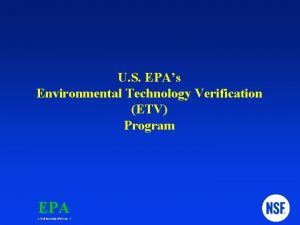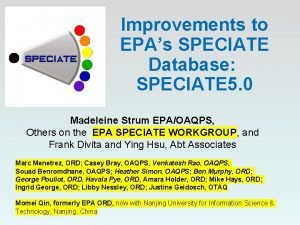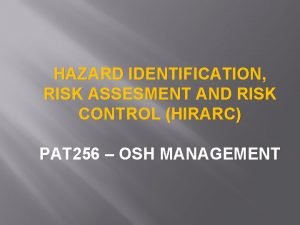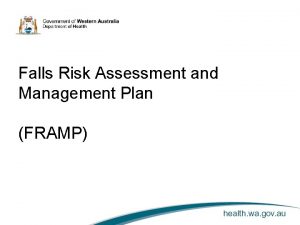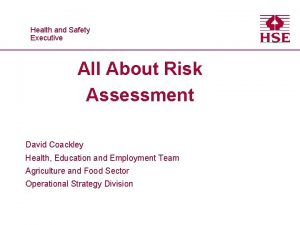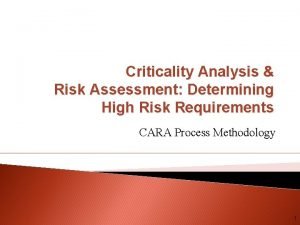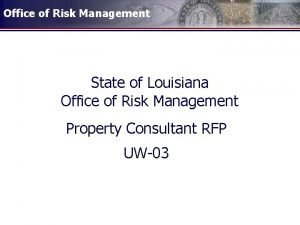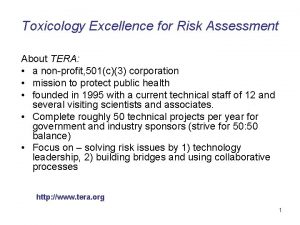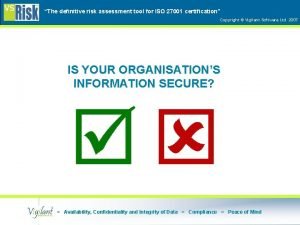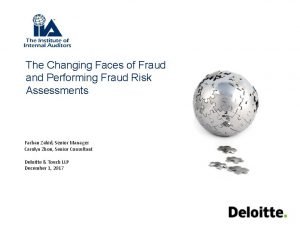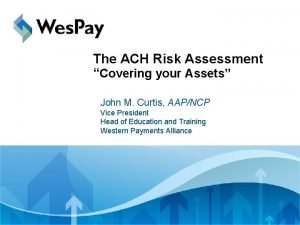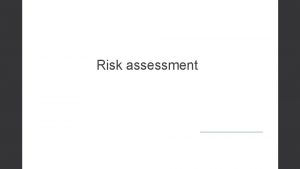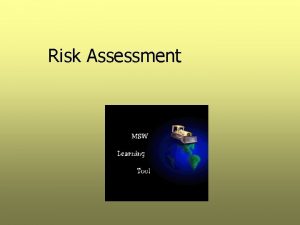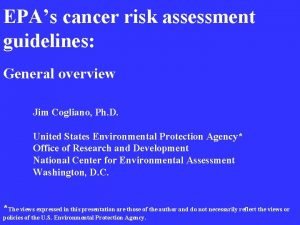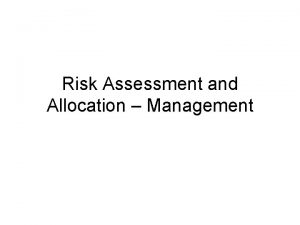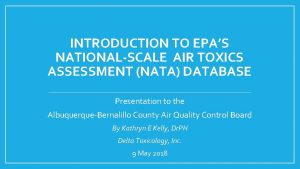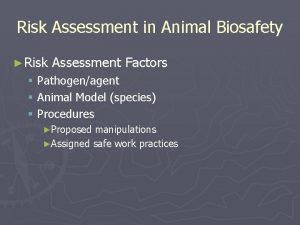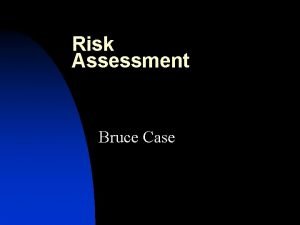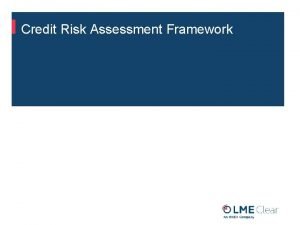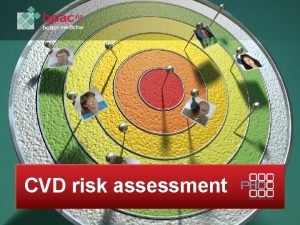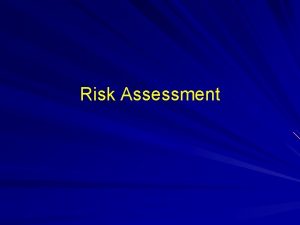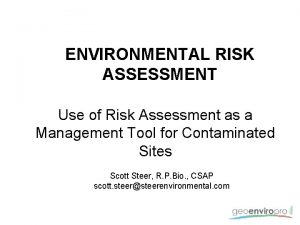Introduction to Risk Assessment and EPAs Office of



































- Slides: 35

Introduction to Risk Assessment and EPA’s Office of Research and Development RISK ASSESSMENT TRAINING AND EXPERIENCE Basics of Risk Assessment University of Iowa Superfund Research Program, Iowa City, Iowa October 2, 2017 Office of Research and Development National Center for Environmental Assessment

Introduction to Risk Assessment and EPA’s Office of Research and Development • • • Introduction Risk Assessment – Paradigm and Definitions How Risk Assessment Informs Risk Management EPA’s Office of Research and Development (ORD) § Mission § Risk Assessment at ORD § Examples Additional Information Disclaimer: The views in this presentation are those of the authors and do not necessarily reflect the views or policies of the EPA. Iowa City, IA October 2, 2017 1

RISK ASSESSMENT PARADIGM

Class Activity How would you define risk? How would you define risk assessment? Iowa City, IA October 2, 2017 3

“Risk Assessment” is Contextual Engineering/ Structural Ecological Financial/ Business Security: Vulnerability and Threat Iowa City, IA October 2, 2017 Human Health 4

EPA Definition of Risk Assessment Risk assessment: Qualitative and quantitative evaluation of the risk posed to human health and/or the environment by the actual or potential presence and/or use of specific pollutants From EPA’s “Terms of Environment” Glossary http: //infohouse. p 2 ric. org/ref/01/00402. htm Iowa City, IA October 2, 2017 5

EPA Definition of Risk: A measure of the probability that damage to life, health, property, and/or the environment will occur as a result of a given hazard From EPA’s “Terms of Environment” Glossary Iowa City, IA October 2, 2017 6

Brief History of Human Health Risk Assessment at EPA • 1970: EPA established • 1975: First EPA chemical assessment (vinyl chloride) § Quantitative Risk Assessment for Community Exposure to Vinyl Chloride • 1976: Interim Procedures and Guidelines for Health Risk and Economic Impact Assessments of Suspected Carcinogens Iowa City, IA October 2, 2017 7

Brief History of Human Health Risk Assessment at EPA • National Research Council (NRC) publications on risk assessment § 1983: Managing the Process – the “Red Book” § 1989: Improving Risk Communication § 1994: Science and Judgment – the “Blue Book” § 1996: Understanding Risk § 2007: Toxicity Testing in the 21 st Century § 2008: Phthalates and Cumulative Risk Assessment § 2009: Science and Decisions – the “Silver Book” Iowa City, IA October 2, 2017 8

Brief History of Human Health Risk Assessment • Presidential Commission on Risk Assessment and Risk Management (CRARM) § Addressed residual risks from HAPs § Developed an integrated risk management approach • Continued evolution at EPA § Multiple chemical (cumulative) risk assessment § Community-scale and nationalscale assessments Iowa City, IA October 2, 2017 9

EPA’s Integrated Risk Information System (IRIS) Definition of Risk Assessment Hazard Identification Dose-response Assessment Exposure Assessment Risk Characterization Risk assessment is the evaluation of scientific information on: § the hazardous properties of environmental agents, § the dose-response relationship, and § the extent of human exposure to those agents. The product of the risk assessment is a statement regarding the probability that populations or individuals so exposed will be harmed and to what degree. From EPA’s IRIS Glossary https: //ofmpub. epa. gov/sor_internet/registry/termreg/searchandretrieve/glossariesandkey wordlists/search. do? details=&glossary. Name=IRIS%20 Glossary Iowa City, IA October 2, 2017 10

Risk Analysis Paradigm Information RESEARCH • Epidemiology Information RISK ASSESSMENT • Clinical studies Hazard Identification • Animal studies Dose-Response Assessment • In vitro & in silico studies Exposure Assessment • Modeling Risk Characterization Research Needs Santiago, Chile April 29 -30, 2014 RISK MANAGEMENT Social Economic Legal D E C I S I O N Ban More research Standards: air, water, food Priorities: research, regulation Assessment Needs 11

Updated Risk Analysis Paradigm Santiago, Chile April 29 -30, 2014 12

Superfund: An Application of Risk Assessment http: //www. epa. gov/oswer/riskassessment/risk_superfund. htm Iowa City, IA October 2, 2017 13

RISK ASSESSMENT TERMINOLOGY

Important Risk Assessment Definitions: Hazard The inherent toxicity of a compound. Hazard identification of a given substance is an informed judgment based on verifiable toxicity data from animal models or human studies. From EPA’s “Terms of Environment” Glossary Iowa City, IA October 2, 2017 15

Important Risk Assessment Definitions: Exposure Quantified as the amount of an agent available at the exchange boundaries of the organism (e. g. , skin, lungs, gut). From EPA’s IRIS Glossary Iowa City, IA October 2, 2017 16

Important Risk Assessment Definitions: Exposure Assessment • Identifying the pathways by which toxicants may reach individuals, estimating how much of a chemical an individual is likely to be exposed to, and estimating the number likely to be exposed From EPA’s “Terms of Environment” Glossary • The determination or estimation (qualitative or quantitative) of the magnitude, frequency, or duration, and route of exposure From EPA’s Exposure Factors Handbook https: //cfpub. epa. gov/ncea/risk/recordisplay. cfm? deid=236252 Iowa City, IA October 2, 2017 17

Important Risk Assessment Definitions: Dose Potential dose: Ingested, inhaled, applied to skin Applied dose: Present in exposure medium (μg / m 3) Internal dose: Amount absorbed and available for interaction (μg / kg) The amount of a substance available for interactions with metabolic processes or biologically significant receptors after crossing the outer boundary of an organism. From EPA’s IRIS Glossary EPA’s Guidelines for Exposure Assessment https: //www. epa. gov/risk/guidelines-human-exposure-assessment Iowa City, IA October 2, 2017 18

Important Risk Assessment Definitions: Dose-Response Assessment • Evaluating the quantitative relationship between dose and toxicological responses. From EPA’s “Terms of Environment” Glossary • A determination of the relationship between the magnitude of an administered, applied, or internal dose and a specific biological response. Response can be expressed as: • Measured or observed incidence or change in level of response • Percent response in a group of subjects (or populations) • Probability of occurrence or change in level of response within a population. From EPA’s IRIS Glossary Iowa City, IA October 2, 2017 19

Example Dose-Response Curves RESPONSE: Fraction of population affected 1 0. 8 0. 6 0. 4 0. 2 0 DOSE: mg/kg-day Iowa City, IA October 2, 2017 20

Important Risk Assessment Definitions: Risk Characterization • The last phase of the risk assessment process that estimates the potential for adverse health or ecological effects to occur from exposure to a stressor and evaluates the uncertainty involved. From EPA’s “Terms of Environment” Glossary • The integration of information on hazard, exposure, and dose-response to provide an estimate of the likelihood that any of the identified adverse effects will occur in exposed people. From EPA’s IRIS Glossary Iowa City, IA October 2, 2017 21

Risk Assessment and Risk Management Are Interrelated Risk Assessment SCIENCE Risk Management POLICY • Some decisions are based on scientific judgment; others are policy • • • decisions informed by science. How separated should risk assessment and risk management be? Most current frameworks recommend an iterative process. Transparency is key: “Conducting a risk assessment in such a manner that all of the scientific analyses, uncertainties, assumptions, and science policies which underlie the decisions made throughout the risk assessment are clearly stated” From EPA’s Thesaurus of Terms Used in Microbial Risk Assessment https: //ofmpub. epa. gov/sor_internet/registry/termreg/searchandretrieve/glossariesan dkeywordlists/search. do? details=&vocab. Name=MRA%20 Thesaurus#form. Top Iowa City, IA October 2, 2017 22

Risk Management Decision Framework EPA’s Risk Characterization Handbook https: //www. epa. gov/risk-characterization-handbook Iowa City, IA October 2, 2017 23

Risk Assessment to Support Risk Management at EPA, the ORD Role

EPA Offices EPA ADMINISTRATOR and DEPUTY ADMINISTRATOR Air and Radiation Chemical Safety and Pollution Prevention Chief Financial Officer Enforcement and Compliance Assurance Environmental Information General Counsel Inspector General International and Tribal Affairs Land Emergency Management Research and Development Water Administration and Resources Management REGIONAL OFFICES Santiago, Chile April 29 -30, 2014 25

ORD’s Mission Provide the science, technical support, technology, and tools to inform EPA’s mission to protect public health and the environment Iowa City, IA October 2, 2017 26

ORD Labs and Centers Iowa City, IA October 2, 2017 27

National Center for Environmental Assessment Resource center for human health and ecological risk assessment NCEA: • • • Develops guidelines, methodologies, and training Creates tools and databases Integrates and applies ORD- and extramural-generated research Performs risk assessments Consults with EPA programs, regions, and decision makers Iowa City, IA October 2, 2017 28

EXAMPLES OF NCEA PRODUCTS USED IN RISK ASSESSMENT

IRIS Values Used in Generation of Fish Advisories • IRIS includes an Rf. D for methylmercury • Rf. D combined with exposure factors and contaminant concentrations • Result is general advice about fish consumption and locationspecific advisories Iowa City, IA October 2, 2017 30

IRIS Values for Superfund Casmalia Resources in Santa Barbara County, CA • Former hazardous waste management facility • Chemicals of concern include pesticides, solvents, acids • (including hydrogen sulfide), PCBs, and heavy metals IRIS values support decisions about remedial actions including landfill covers, groundwater monitoring, and site improvements Iowa City, IA October 2, 2017 31

Integrated Science Assessments The ISA accurately reflects “the latest scientific knowledge useful in indicating the kind and extent of identifiable effects on public health which may be expected from the presence of [a] pollutant in ambient air. ” (Clean Air Act, Section 108, 2003) ISA for Carbon Monoxide – January 2010 ISA states “that a causal relationship is likely to exist between relevant short-term CO exposures and cardiovascular morbidity. ” Iowa City, IA October 2, 2017 32

Wrap Up • EPA has been a leader in the environmental risk assessment field since the 1970 s • A basic paradigm (with associated terminology and concepts) guides the application of risk assessment principles § Terms can vary by context § Processes continue to evolve • ORD products and guidance are crucial for EPA risk assessments Iowa City, IA October 2, 2017 33

Contact Information Xabier Arzuaga, Ph. D arzuaga. xabier@epa. gov 1 -703 -347 -8634 Iowa City, IA October 2, 2017 Geniece Lehmann, Ph. D lehmann. geniece@epa. gov 1 -919 -541 -2289 34
 Epas
Epas Epas enablers
Epas enablers Epas technologies
Epas technologies Jonas radvanas
Jonas radvanas Epas database
Epas database Credit risk market risk operational risk
Credit risk market risk operational risk Residual risk and secondary risk pmp
Residual risk and secondary risk pmp Business vs financial risk
Business vs financial risk Relative risk and attributable risk
Relative risk and attributable risk Parirt
Parirt Factory office plan
Factory office plan Hirarc assignment
Hirarc assignment Framp falls risk
Framp falls risk Health and safety risk assessment template
Health and safety risk assessment template Population health risk assessment and management
Population health risk assessment and management Criticality analysis and risk assessment
Criticality analysis and risk assessment Risk projection attempts to rate each risk in two ways
Risk projection attempts to rate each risk in two ways Risk reduction vs risk avoidance
Risk reduction vs risk avoidance Relative risk calculation
Relative risk calculation Inherent risk vs control risk
Inherent risk vs control risk Absolute risk vs relative risk
Absolute risk vs relative risk Thinking algebraically stock market game answer key
Thinking algebraically stock market game answer key Medium-term risk examples
Medium-term risk examples Risk financing transfer adalah
Risk financing transfer adalah The biggest risk is not taking any risk
The biggest risk is not taking any risk Key risk indicators template
Key risk indicators template Business risk vs audit risk
Business risk vs audit risk Risk map
Risk map Orm louisiana
Orm louisiana Family office risk
Family office risk Introduction to risk and return
Introduction to risk and return Toxicology excellence for risk assessment
Toxicology excellence for risk assessment Caries risk assessment form
Caries risk assessment form Iso 27001 software tools
Iso 27001 software tools Check kiting example
Check kiting example Ach risk assessment
Ach risk assessment


